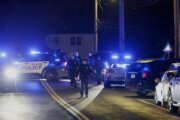WASHINGTON — Passengers on Daallo Airlines flight D3159 leaving Mogadishu Feb. 3 experienced something that expert terrorism investigators say is extremely rare.
They witnessed an explosion on their plane, saw a man sucked out of a gaping hole in the fuselage and lived to tell about it.
A man believed to be have been attached to Al Shabaab boarded the flight with a laptop Somalian civil aviation officials say two men gave him in the airport. CCTV footage shows the exchange. Somalian aviation officials say the laptop was the key to the explosion. It’s believed the bombmaker built and loaded an explosive device inside the laptop that was detonated by the man blown out of the plane.
Investigators say the fact that the device was detonated at 11,000 feet instead of 30,000 is why only the bomber was killled. At a higher altitude, experienced pilots say, the hole the explosion caused would have led to catastrophic structural damage to the plane.
The crew was able to land the plane safely with injuries to only two of the 73 passengers aboard.
As a result, the Transportation Security Administration, which had previously begun tightening security, is taking an even closer look at air carriers that fly into the U.S.
TSA Administrator Peter Neffenger told WTOP the agency is “paying very close attention to our processes, procedures and technologies designed to detect items that could harm an aircraft, damage an aircraft or destroy an aircraft.”
Speaking the day after the Daallo Airlines attack, Neffenger said TSA is intensifying efforts to “look at the people that are coming on board, what they are carrying on board, the cargo that comes on board. We’re also looking at all the systems designed to handle that.”
The Daallo Air attack took place four months after Metrojet Flight 9268 blew up and crashed in Egypt’s Sanai region. Western investigators say they believe a bomb was put on the aircraft at Sharm el-Sheikh International Airport. The explosion killed 224 people.
The Islamic State of Iraq and the Levant (ISIL) claimed responsibility for that attack.
In November, ISIL published pictures of what it said was the bomb in an online magazine, claiming to show the three improvised explosive device components — a Schweppes soda can containing the explosive charge, a military-grade detonator and a switch.
Terrorism experts say that since the Metrojet crash, terrorists are becoming more skillful at creating bombs and slipping them past security. And Neffenger said TSA has seen evidence of a developing competition among terrorists.
Neffenger said events in the last few months have made it clear that the threat to aviation in certain countries is much higher than at any time in recent years, and “that competition means that the environment is a little more uncertain than it was before. …
“You have a number of different, very prominent groups that have expressed a desire to attack Western interests and Western aviation, and we’re seeing new players that want to get in the game. You’re talking about ISIL, al-Qaida core and other splinter groups that have attached themselves respectively to one of the two of those primary groups,” Neffenger said.
“As we look at things like the Metrojet incident over the Sinai, we still don’t have full details on what that was, but we proceed on the assumption of that it was the device implanted on that plane to blow it up. That just tells us that there are more potential threats out there than it might have been in the past.”
Mogadishu, in a persistent state of conflict for decades and a focal point of the terrorist group Al Shabaab, is one of the places those threats manifest very often. The airport is notorious for lax security.
The pilot of the Daallo Airlines flight, Vlatko Vodopivec, told the Associated Press that the airport is extremely vulnerable.
“The security is zero. When we park there, some 20 to 30 people come to the tarmac,” said Vodopivec, a veteran pilot who has made numerous flights to the airport. “No one has a badge or those yellow vests. They enter and leave the plane, and no one knows who is who.”
The Daallo airlines case has left seasoned investigators such as Fred Burton, vice president of intelligence at Stratfor — a global intelligence company — with an uneasy feeling.
“Yes, the bad guy is dead and the FBI is on the case, but the critical factor is, who built the bomb? Until that person is found, you have a serious threat to aviation all over the world,” Burton said.
Burton, a retired State Department counterterrorism investigator, said this case raised another important question: “Was this a test to see if you could get a device on an airplane heading to the U.S.?”





